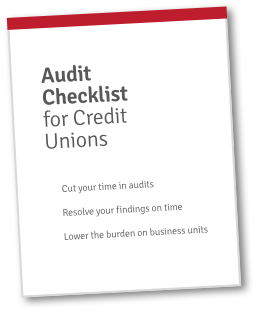Credit unions deal with several audits per year. Some might even say “too many.” And each audit is a little like a math test in school:
- You must prepare for it
- You have only a limited time to complete it
- There are lots of numbers and equations involved
- You must show your work
- You can’t cheat
But just imagine if you could cheat. Just a little. Just enough to make it a little easier.
That’s what today’s blog is about. Actually, it’s more about the fourth option—showing your work—but we’re going to make it feel like cheating. How are we going to do that, you ask?
Automated audit working papers for credit unions.
The Anatomy of a Credit Union Audit Program
Most credit unions rely on outsiders in their audit programs. They outsource a good deal of the labor to audit firms, who do a good deal of the legwork for them.
The credit union’s role in this case is to quarterback the process. They make sure that document requests coming in are fulfilled. They make sure everything is executed on time, that due dates are met, and that observations are tended to. They also manage the findings process. But overall, they’ve not typically very involved in the details of the work program.
Some credit unions—generally the larger ones, or those with more complex or rigorous audit programs—also do some work internally. Some credit unions work internally on a few audits per year. Other credit unions do more.
For the credit unions who handle portions (or all) of the audit internally, they need a way to manage their work program. Here’s some of what that entails:
- Clearly-defined audit steps
- Documented workflows, changes, access, and basically everything
- Review of completed steps and items
- Storing audit history
- Connecting audit history with the findings of other audit results during the audit as well as after
Essentially, credit unions working internally need to have clear, documented, and reviewed structure. To a lesser extent, the same holds true for credit unions who don’t work their own audits. Even managing an audit requires a level of rigid documentation.
Where Audit Working Papers Come In
Clearly, there are a lot of different things to manage during an audit. Knowing who is doing what, and when, and why are all crucial. Plus, keeping track of everything listed above can be quite a bear.
And, just like a math test, credit unions have to be prepared. More importantly, they have to hit their deadlines. And, most critically of all, they have to show their work.
In an audit, you can’t just give someone an answer without explaining how you got that answer. Also, everyone involved in giving that answer, especially if they accessed it later and revised it, has to show their work.
All of this is tracked in audit working papers. Over the course of an audit, they show who did what, when, and why. They are, in many ways, something like a very robust audit trail. Documenting each and every step and change is a lot of manual work.
Automated audit working papers take out a good deal of that manual work. They can keep automated logs of who changed things, and when.
Which Credit Unions Benefit from Automated Audit Working Papers?
All credit unions benefit from automated audit working papers. They remove some of the tedious manual work and reduce error. They also automatically perform tasks—like documentation—that would otherwise be completed by hand.
Regardless of whether a credit union only manages exterior auditors or if they work their own internal audits, automated audit working papers reduce a significant manual workload.
In so, so many ways, automation in audits feels like cheating. (It all comes full circle, doesn’t it?)

FREE: Audit Checklist for Credit Unions
4 key principles and 9 questions to jumpstart your audit planning. From leading credit unions.Further Reading About Automation
If you’d like to read more about credit union audits—and how you can automate portions of them—then follow the links below! Redboard has been working diligently to reduce the effort required of credit union audit teams. You may find something that helps you save time on audits.
In fact, we recently helped a credit union reduce their audit completion time by 25%! They now reinvest their time for more strategic goals.
If you’d like to see how else we can help you with your audits, you can check out our 11 audit efficiency tips or our credit union audit checklist. Or, if you don’t want to miss great content weekly, subscribe to our blog!
HOW AUTOMATION IN AUDITING IMPROVES ACCOUNTABILITY
AUDIT AUTOMATION SOFTWARE FOR CREDIT UNIONS: THREE SIMPLE OPTIONS





